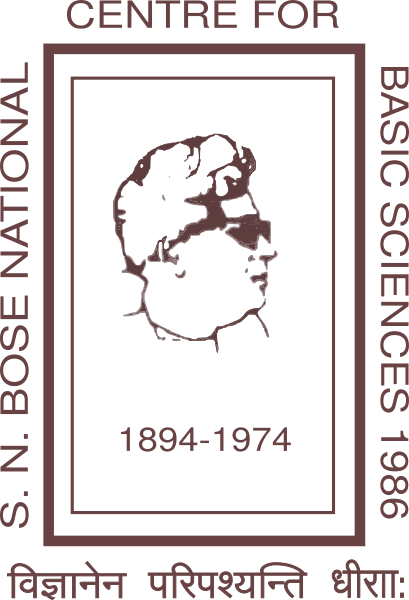Department of Astrophysics and High Energy Physics
Contents
Research Accomplished
- We have proposed and demonstrated the existence of hermitian witness operators to detect entanglement useful for quantum teleportation and other information processing resources
- We have developed linkages of quantum foundational principles with information theoretic resources, such as quantum uncertainty with purity, nonlocality and quantum memory
- We have shown that primordial black holes could grow due to accretion of radiation and survive up to much later eras of observational relevance in different cosmological models, leading to modification of the stochastic background of gravitational waves
- Multiple use of a single copy of an entangled quantum state is a resource-efficient method for implementing practical information processing protocols. We are the first to provide an analytical proof of Bell-nonlocality sharing by at most two sequential observers on one wing of an entangled pair of qubits. This has been followed up by our subsequent demonstrations of sharing of steerability, sharing of the nonlocal advantage of quantum coherence, and sharing of tripartite entanglement.
- Einstein-Podolsky-Rosen (EPR) Steering proposed by Schrodinger in 1935, is now regarded to be of tremendous importance in security of quantum key generation protocols implemented in upcoming quantum technologies. We have addressed a number of key conceptual issues regarding EPR steering in the contexts of non-Gaussian states, fine-grained uncertainty for discrete and continuous variable systems, sum-uncertainty relations, measures of steering, and tripartite steering.
- In a study of fermions in curved spacetimes -- this dynamically generates a torsion field, we have suggested that this torsion may couple chirally to the fermions, leading to novel four-fermion interactions which may modify neutrino oscillations among other things.
- We studied the dynamics of electrons in presence of vortex strings, and calculate the effective interaction. The study showed that it is possible for electrons to pair up by being connected via vortex strings, leading to the possibility of having localised pairs in some superconductors.
- Developed a method for constructing theories in curved background that yields a dynamical realisation of Newton Cartan geometry.
- Formulated a generalised Noether approach that is useful in studying field theories with global symmetries that go beyond the usual charge conservation.
- We explored the fast rotation (in the time-scales of hours) in Very Low Mass stars (VLMs) and Brown Dwarfs (BDs) in star-forming regions IC 348 and Taurus: variability and detection of flare in M dwarfs to understand the atmospheric properties. Interestingly, an optical flare is detected in a young M2.75 dwarf with the emitted flared energy of 1.48×1035 erg. The observed flared energy with an uncertainty of tens of percent is close to the superflare range (∼1034 erg), which is rarely observed in active M dwarfs (Samrat Ghosh et al., MNRAS, 2021; 2022).
- About 200 member candidates have been identified on the basis of proper motion and parallax measured by the Gaia DR2 with an age of ~15 Myr in a comprehensive study of Galactic open cluster M 36. We discover a highly obscured (AV up to ~23 mag), compact dense cloud, within which three young stellar objects in their infancy (ages less than 0.2 Myr) are identified. If the physical association between M 36 and the young stellar population can be unambiguously established, this manifests a convincing example of prolonged star formation activity spanning up to tens of Myr in molecular clouds (Alik Panja et al., APJ, 2021).
- Using a sample CARMENES high-resolution NIR spectra (R ~90,000) of 271 M-dwarf stars (M0V-M7V) and TIRSPEC low-resolution (~1200) NIR spectra, we derive empirical calibration relationships to estimate the fundamental parameters of these low-mass stars. We select a sample of nearby and bright M-dwarfs as our calibrators for which the physical parameters are acquired from high-precision interferometric measurements (Khata et al., MNRAS, 2020; 2021).
- We have been trying to look at the effects of quantum gravity in various physical processes such as the spontaneous excitation of a two-level atom in the presence of a perfectly reflecting mirror, when the atom, or the mirror, is uniformly accelerating in the framework of the generalised uncertainty principle (GUP). We show that in the case when the mirror is accelerating, the GUP modulates the spatial oscillation of the excitation probability of the atom, thus breaking the symmetry between the excitation of an atom accelerating relative to a stationary mirror, and a stationary atom excited by an accelerating mirror. An explicit violation of the equivalence principle seems to be thus manifested. We further obtain an upper bound on the GUP parameter using standard values of the system parameters.
- We perform studies on understating the physical and chemical parameters of the astronomical objects (e.g. Novae, Planetary Nebulae (PNe) etc.) through modeling of observed, archival and published spectra as well as images. We achived several important results. Estimated the physical parameters of nova V1280 Scorpii at pre- and post-dust phase by modeling optical/near-Infrared spectra. In another study, using the HST Hα image of the compact PN PB 1, we have constructed the 3D structure of the PN and estimated related parameters.
- Faculty members in DAHEP have expertise in instrumentation, data analysis and software development, and have worked for MAGIC and IceCube Collaborations, and presently a member of Hyper-Kamiokande and CTA (Cherenkov Telescope Array) collaborations.
- We explored the role of filamentary structures in Galactic star formation. In a project using high resolution mm-band data from Atacama Large Millimeter/submillimeter Array (ALMA), our investigation show no preferred orientation of outflow axes in comparison to their host filaments. This result implies that the filaments might not have any significant role in channeling gas on to the protostellar accretion disk (Baug et al., 2021, ApJ)

